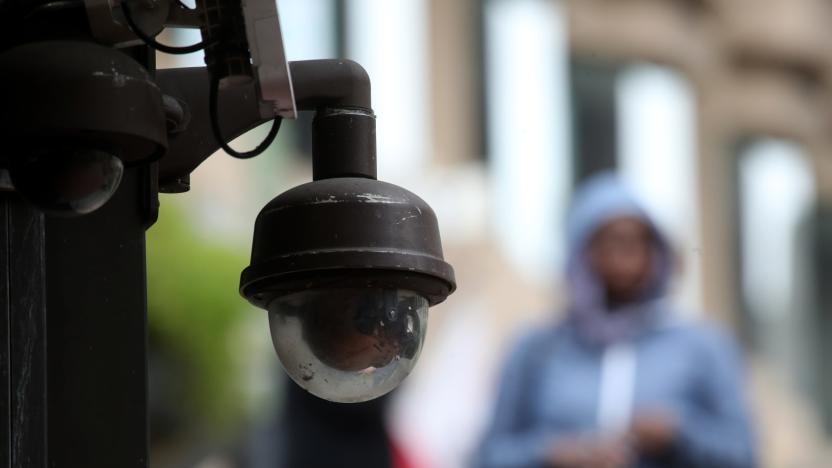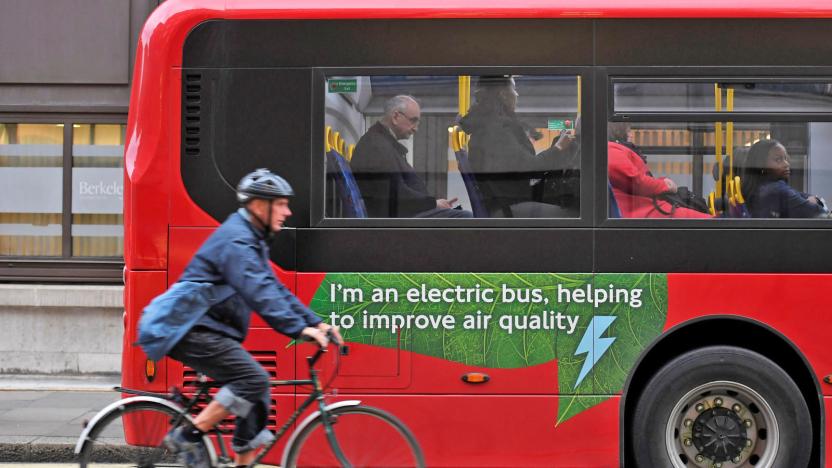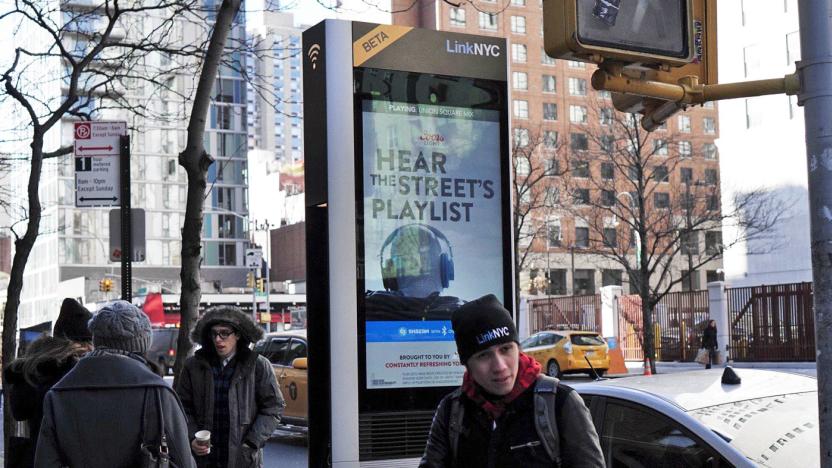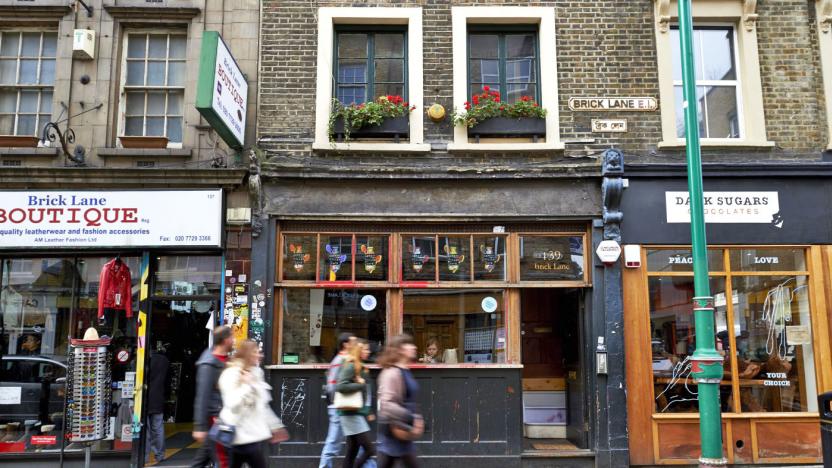city
Latest

Volkswagen's ID.Life is an urban EV that will enter production by 2025
Volkswagen has added another piece to its EV puzzle with the launch of the ID.Life concept, a front-wheel drive EV aimed at city-dwellers.

Uber and Lyft admit they're making city traffic worse
Uber and Lyft may be competitors but as the two major ridesharing companies, they also have a lot in common -- including the challenges they face. To better understand their role in city traffic patterns, the companies jointly sponsored a study to determine their combined vehicle miles traveled (VMT) in six key cities. In a surprising twist, the results got Uber to admit that ridesharing companies, or transportation network companies (TNCs), do in fact contribute to congestion.

Oakland bans city use of facial recognition software
Oakland, Calif. is now the third US city to ban the use of facial recognition technology. The city passed an ordinance yesterday that prohibits the use of the technology on the grounds that it is often inaccurate, potentially invasive and lacks standards. "Face recognition technology runs the risk of making Oakland residents less safe as the misidentification of individuals could lead to the misuse of force, false incarceration, and minority-based persecution," Council President Rebecca Kaplan wrote in a letter recommending the ban.

A ransomware attack is holding Baltimore's networks hostage
A ransomware attack brought Baltimore city government's computers to a halt yesterday. The hackers are reportedly holding the city's files hostage, demanding up to 13 Bitcoins (about $76,280) to free the city's systems. As of this afternoon, the city has quarantined the ransomware, the Baltimore Sun reports. But, in a press conference, the city said it is not sure when all of the systems will be functioning again.

CO2 emissions in 27 major cities have declined since 2012
There is some good news about efforts to fight human-made climate change. The C40 Cities group, which unifies climate initiatives in 96 urban areas around the world, reported that CO2 emissions peaked in 27 major cities (including London, New York City, San Francisco, Paris and Toronto) by 2012, and have been declining by an average of 2 percent each year since then. Greenhouse gas levels were "at least" 10 percent higher at peak than during the most recent study, C40 said. And that's despite economies and populations that have grown since then.

The West Coast is finally getting an earthquake early warning system
On September 19th, 1985, Mexico City was devastated by an 8.0 magnitude earthquake that killed as many as 30,000 people and leveled buildings across the city, including the 12-story Hospital Juárez, one of the oldest hospital institutions in Mexico. In response, the government set about creating the world's first earthquake warning system. One that, when an 8.1 tremblor set in on the city September 7th of this year, and a second 7.1 less than two weeks later, saved potentially tens of thousands of lives by giving them more than a minute's notice to head to safety. So why doesn't America have one along its Pacific coast as well? Turns out we almost do.

Airbnb helps hosts in San Francisco get city approval online
Airbnb has had a bumpy ride in San Francisco. After the city passed a law that required all short-term rental hosts to register with the city, only a small percentage did (thanks largely to the onerous process involved), and many of those who didn't were hit with fines totalling $1 million. Differences were set aside in January though, when the parties agreed on a way to automatically register all hosts in the city. That service rolls out today, with hosts now able to apply directly through the Airbnb site for their Short-Term Residential Rental Certificate and Business Registration Certificate, instead of schlepping down to City Hall. New hosts will only be able to list their properties once they're registered, while existing hosts will have to input their registration number to keep their listings active.

AI vision can determine why neighborhoods thrive
It's relatively easy to figure out whether or not a neighborhood is doing well at one moment in time. More often than not, you just have to look around. But how do you measure the progress (or deterioration) a neighborhood makes? That's where AI might help. Researchers have built a computer vision system that can determine the rate of improvement or decay in a given urban area. The team taught a machine learning system to compare 1.6 million pairs of photos (each taken several years apart) from Google Street View to look for signs of change on a pixel-by-pixel, object-by-object basis. If there are more green spaces or key building types in the newer shot, for instance, that's a sign that an area is on the up-and-up.

Google sister company wants to build smart city districts
Forget just providing internet access on city streets -- Google's sister firm Sidewalk Labs wants to create whole smart neighborhoods. Wall Street Journal sources hear that Sidewalk is about to propose to Alphabet that it should design whole city districts with technology in mind. It wants to revamp existing areas (likely in declining cities) with everything from higher-tech electrical grids to self-driving cars. It's even hoping to get city regulation waivers so that it can experiment with elements as basic as street design.

You can predict city gentrification through check-ins and tweets
Do you dread the thought of gentrification jacking up real estate prices (and stifling culture) in your neighborhood? In the future, you might only need to keep tabs on social networks to know when your part of town is changing -- British researchers have learned that Foursquare check-ins and Twitter posts can help predict gentrification. If many people start visiting unfamiliar locations in materially-deprived neighborhoods (say, trendy new restaurants) with their friends, that's usually a good sign that these areas will be gentrified before long. Accordingly, places that are dominated by locals and regulars tend to resist that shift, no matter the income levels.

6 self-contained skyscraper super cities
By Cat DiStasioToday's architects are imagining the cities of the future as building styles fall in and out of fashion and construction materials evolve. As urban centers get more crowded and polluted, a number of forward-thinking designers are responding with concepts for self-contained super cities that reach up instead of out -- sometimes up to 2.5 miles high. The resulting designs incorporate renewable energy, indoor farms and living space for thousands of people, with the idea that self-sustaining and self-contained communities can exist outside the constraints of climate change without contributing to it further.

Gett's latest expansion takes it beyond Uber in the UK
Uber is finally starting to ramp up its operations in the UK, but it faces tough competition from taxi-booking app Gett. Formerly known as GetTaxi, the company is expanding into 18 new cities today: Oxford, Cambridge, Reading, Slough, Milton Keynes, Brighton, Bristol, Bath, Cardiff, Portsmouth, Bournemouth, Leicester, Coventry, Sheffield, Nottingham, Bradford, Hull, and Newcastle. They join London, Edinburgh, Manchester, Birmingham, Liverpool, Glasgow and Leeds, taking the app's coverage far beyond its ride-hailing rival.

London tests traffic lights that stay green for cyclists
Cycling is one of the quickest ways to get across London, and soon adaptive traffic lights could make pedal-power even faster. Transport for London (TfL) is testing a system that detects groups of cyclists and, where possible, keeps the lights green for a little longer than usual. The problem being that during peak times -- for instance, the morning commute -- tons of cyclists take to the streets, causing congestion at major junctions.

The Daily Grind: What's the worst-designed MMO city?
One of my personal pet peeves in any roleplaying game is to have to navigate around an overly large city. I guess I'm just not a city guy at heart. But that annoyance is doubly so for any video game metropolis that suffers from poor design. I can name several examples, although today World of Warcraft's Undercity springs to mind. While delightfully atmospheric, it was nevertheless a pain in the tuckus to traverse. There were too many elevators, vertical space, and long, long runs around the outer circle, all of which kept me away if I could help it. What do you think is the worst-designed MMO city and why? Every morning, the Massively bloggers probe the minds of their readers with deep, thought-provoking questions about that most serious of topics: massively online gaming. We crave your opinions, so grab your caffeinated beverage of choice and chime in on today's Daily Grind!

RuneScape's Lost City of the Elves expands further
RuneScape's been going gaga over the unveiling of its Lost City of the Elves since it opened its doors for business back in September. However, that release was only part of the Lost City, since Jagex "found" more of it to put out the door today. After much anticipation, the second half of Prifddinas is now live in RuneScape. The city was "designed for and by the high-level community" and now includes four new clans with specialized offerings. Jagex said that there are eight additional skills for players to learn and plenty of secrets tucked away in nooks and crannies. We've got a video of the Lost City that you can check out after the break!

Take a 3D tour of London with Google's latest Maps update
If you've ever wanted to explore London but haven't been able to fund the trip, Google wants to lend a hand. As part of its latest update, the search giant has unveiled a new 3D model of the city in both Maps and Google Earth, allowing you to pan, zoom and rotate your way down the Thames and past its popular landmarks. London is actually the fifth English city to appear in 3D on Google Maps after Reading, Leeds, Birmingham and Stoke on Trent, while Apple has offered similar (but maybe not as detailed) flythroughs of the capital for some time. Google is quick to point out that its 3D imagery covers the whole city, not just tourist spots and other iconic locations, so if you have some time to kill, head on over to the source link below and get explorin'.

Dubai's beating the heat with Mall of the World, a massive climate-controlled city
Dubai is hot. Summer temperatures can easily exceed 110 degrees Fahrenheit, and desert conditions can mean weeks without relief. The city is already home to a slew of all-weather venues, such as Ski Dubai, the Middle East's first indoor ski resort, but the UAE's latest project could bring comfort to millions of residents and annual visitors. Mall of the World, as the complex is to be named, will include 20,000 hotel rooms, making up some 100 hotels and apartment complexes, the world's largest indoor theme park, an 8-million square foot mall and a 3-million square foot "wellness district," with doctors and inpatient facilities for medical tourists.

Madrid's parking meters now charge extra if you drive a fuel hog
Madrid has an air quality problem, and it's taking an unusual approach to getting the offending vehicles off the road: it's discouraging their drivers from parking. As of today, the city's smart parking meters charge up to 20 percent extra if you drive a car that's likely to either be a fuel hog or put out a lot of exhaust fumes, such as pre-2006 diesels. Conversely, you'll get a discount as high as 20 percent if you're driving a newer (and presumably cleaner-running) car; it's completely free if you're using an electric vehicle. The system is based on a simple license plate check, although it's accompanied by parking space sensors that make you pay more if you're using up one of the last available spots.

Chicago is getting lamp posts that count people and track pollution
Apparently, Chicago is becoming even more like its Watch Dogs doppelganger than we first thought. Researchers are deploying networked, sensor-equipped lamp posts from this July onward to learn how they could help urban planning and safety. They'll collect environmental data like air quality, noise levels and wind, and they'll also measure foot traffic by counting the number of passing cellphones. If the project takes off, Chicago officials could easily tell if air pollution is on the rise, or if a narrow sidewalk is creating a choke point.

Here's what the iPhone reveals about suburbanites vs. city dwellers
I grew up in the suburbs. The first 20 years of my life, I was stuck, dumb and happy, in the Midwestern suburbs. I thought the 'burbs had everything I needed: Targets, Applebee's, corporate chain restaurants and car dealership after car dealership. When I moved to Chicago for my junior year of college, I realized how closed-minded my existence had been. Cities, I found, offered everything the burbs did not: art, culture, neighborhood family-run restaurants, diversity, hope for a job that wasn't based in an office park. I loved the city so much, I lived in Chicago for eight years before moving to London, where I've lived for the past five years. This Christmas, I returned home to the 'burbs for the first time in two years. And thanks to the iPhone 5s' M7 motion coprocessor, which allows me to capture and quantify my movement data, I made a startling discovery that further drove a wedge between city life and suburban life: Compared to city dwellers, suburbanites are just lazy. Below is a screenshot from the Pedometer++ app I use on my iPhone 5s to view my motion data. That app is set to make sure I hit 10,000 steps a day. Days in green are where I have met or exceeded that goal. Days in orange are where I've hit it about halfway, and days in red are where I wasn't even close. Take a look at it and then scroll down. At the very bottom of the image, from Monday, December 16 to Sunday, December 22 is a normal day/week for me in London. That's me going about my normal activity in the UK's capital: walking to the train, walking to the grocery store, walking to the café. Then look what happened on December 23rd. Most of the morning I was in London, but then I hopped on a 12 hour flight back to St. Louis where I was met with something almost everyone in the suburbs have: a car. Now look at December 24 to January 2. That's me, back in the American suburbs, with a car. I'd drive everywhere I'd normally walk to in London. Seeing friends, going out to eat, running to the grocery store. I was never under the pretense that people in the 'burbs walked more than people in the city, but I had assumed they walked at least about 75 percent as much as city dwellers do. But thanks to the iPhone's M7 motion coprocessor, I could see for the first time ever -- with indisputable quantified data -- just how wrong I was. To be fair to all my suburban friends, calling them "lazy" is a bit much. The American suburbs, after all, are designed with cars in mind, which has led to a mindset that it's completely normal to drive everywhere -- even if you could walk there in 20 minutes. Matter of fact, one day I decided to walk to the grocery store from my mom's house and when I got to the major road in town and crossed it drivers in passing cars cast glances at me like they were sure I had gotten a DUI since I was walking somewhere. At the very top of the screenshot from January 3 on up -- back in the green -- is me, back in London where I first looked at Pedometer++'s data since I had left. Looking at the data, I was shocked at what I found, but it also made me hopeful. In today's world, it's ever-harder to live healthy, but thanks to advanced sensors that now live in our phones, we at least have the tools to help us better keep track of our lifestyles -- and maybe help us make choices based on that data to lead healthier lives. PS: The iPhone 5s' M7 motion coprocessor also has an added benefit: It shows just how ridiculous United Airlines' scheduling is. The screenshot below is from the Moves app, which takes advantage of the M7 to show how much you run, walk, cycle and use transport in a day. On December 23, the busiest traveling day of the year, United decided that international fliers arriving at Washington Dulles only needed a 45-minute window to disembark, get through US customs, claim their bags, recheck their bags and then make their connecting flight (when the flight was originally booked it was a 95-minute window--something United decided to change three months after the tickets had been bought...a discretionary change at the airline's whim that is legal under US aviation laws). Thanks to the M7 coprocessor in my iPhone, I can view my experience of getting off my plane from London, walking (in green) to US customs and immigration, where I was greeted with a three-hour wait and 600 fliers in front of me. That white blip is the five minutes it took me to decide to cut in front of those 600 now screaming people, run through customs, and then (in pink) sprint two miles like a bearded madman through the airport (after abandoning my bags, no less) to make my connecting flight home to see my family for the first time in two years (United wanted to bump me to a new flight on the day after Christmas). Thanks, Apple, for the M7 and the data it shows you -- and a big "no-thanks" to ever flying on United again.










